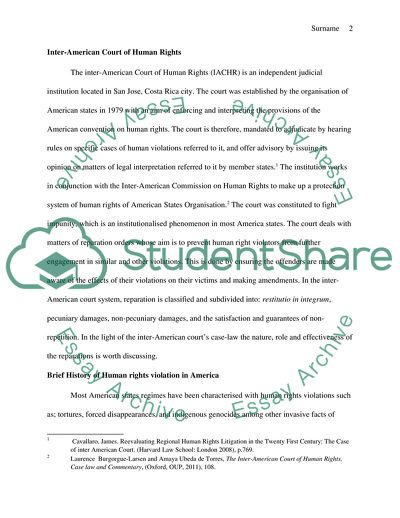Cite this document
(Inter-American Human Rights Case Study Example | Topics and Well Written Essays - 3500 words, n.d.)
Inter-American Human Rights Case Study Example | Topics and Well Written Essays - 3500 words. https://studentshare.org/law/1820032-reparation-orders-are-a-powerful-tool-of-the-inter-american-court-in-its-efforts-to-fight-against-impunity-in-the-americas-discuss-their-nature-role-and-effectiveness-in-light-of-the-courts-case-law
Inter-American Human Rights Case Study Example | Topics and Well Written Essays - 3500 words. https://studentshare.org/law/1820032-reparation-orders-are-a-powerful-tool-of-the-inter-american-court-in-its-efforts-to-fight-against-impunity-in-the-americas-discuss-their-nature-role-and-effectiveness-in-light-of-the-courts-case-law
(Inter-American Human Rights Case Study Example | Topics and Well Written Essays - 3500 Words)
Inter-American Human Rights Case Study Example | Topics and Well Written Essays - 3500 Words. https://studentshare.org/law/1820032-reparation-orders-are-a-powerful-tool-of-the-inter-american-court-in-its-efforts-to-fight-against-impunity-in-the-americas-discuss-their-nature-role-and-effectiveness-in-light-of-the-courts-case-law.
Inter-American Human Rights Case Study Example | Topics and Well Written Essays - 3500 Words. https://studentshare.org/law/1820032-reparation-orders-are-a-powerful-tool-of-the-inter-american-court-in-its-efforts-to-fight-against-impunity-in-the-americas-discuss-their-nature-role-and-effectiveness-in-light-of-the-courts-case-law.
“Inter-American Human Rights Case Study Example | Topics and Well Written Essays - 3500 Words”. https://studentshare.org/law/1820032-reparation-orders-are-a-powerful-tool-of-the-inter-american-court-in-its-efforts-to-fight-against-impunity-in-the-americas-discuss-their-nature-role-and-effectiveness-in-light-of-the-courts-case-law.


